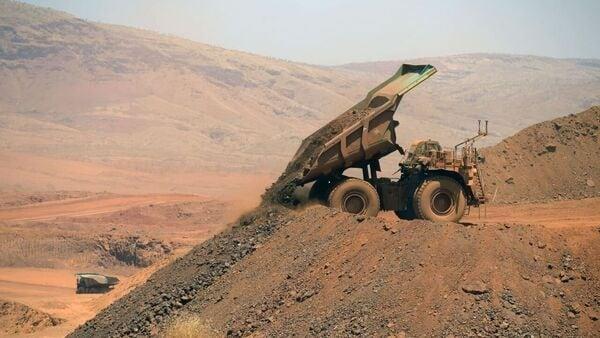Govt May Transfer Idle Mines, Levy Export Tax To Boost Iron Ore Supply
The government could reallocate these mines either through fresh auctions, or transfer them to state-run firms to boost output of iron ore, according to a senior government official and industry executives, all of whom spoke on the condition of anonymity.
Several steps to bolster iron ore supply, including auction of around 20 million tonnes of ore lying at pre-auction mine sites, and expansion of state-run NMDC's mining capacity, were discussed at a high-level inter-ministerial meeting last week. Union commerce minister Piyush Goyal and Union mines minister G. Kishan Reddy, among others, attended the meeting, according to an industry executive who was part of the deliberations. NMDC, India's largest iron ore producer, had a mining capacity of 55 million tonnes as of 31 March.
Also Read | India's top steelmakers take diverging paths on iron ore sourcingIndia is keen on boosting iron ore supplies, and by extension steel, to expand its infrastructure development and accelerate economic growth.
In the 26 August meeting, in which senior Union ministers, Odisha government officials, and top mining and steel industry representatives were present, the Centre warned of strict action, including forfeiture of leases, against companies that won mine auctions but have failed to start operations, said the executive cited earlier.
Export duty proposedAmong the measures discussed to augment domestic availability of iron ore was a potential 20% export duty from October if iron ore production did not increase and prices remained high. India currently levies nil export duty on low-grade iron ore, and charges a 30% tax on high-grade iron ore.
The meeting was attended by industry experts and representatives from top domestic steelmakers like JSW Steel's Sajjan Jindal, Jindal Stainless Ltd (JSL), ArcelorMittal Nippon Steel India's (AM/NS India) Dilip Oommen and other major miners.
Emails sent to the ministry of commerce, JSW Steel, Tata Steel, JSL, AMNS India, and OMC did not elicit any response.
India's iron ore production rose 5% to 289 million tonnes in FY25, according to data from Big Mint, a market intelligence firm. This was a little over half of the 460 million tonnes permitted under environmental clearances. Since 2015, about 135 iron ore mines have been auctioned, but only around 35 are operational.
Also Read | Slide in iron ore prices a hiccup for miners amid copper scrambleOdisha, Chhattisgarh, Karnataka, Jharkhand, and Maharashtra are the top five iron ore producing states in India.
In the meeting, the government official cited earlier said that Goyal expressed concern over rising iron ore prices and asked industry leaders to take all necessary steps, including increasing supply, to bring them down by October, noting that the surge was inflating steel prices.
An increase in supply could help lower raw material costs and soften steel prices, enabling dopmestic producers combat cheap imports from China, Japan, Vietnam and South Korea.
Export potentialWhile unveiling the Bharat Buildcon 2026 exhibition on 29 August, Goyal highlighted the vast export potential in steel and iron ore, noting that India could export 50 million tonnes of steel annually, strengthening its export basket with high-quality, competitively-priced products.
In April this year, prime minister Narendra Modi outlined a target of 25 million tonnes of steel exports by 2030, compared to 4.85 million tonnes in FY25.
“Iron ore production in the country has been growing at around 4-5% CAGR in recent years, while steel production has been rising at a faster pace of 8-9% CAGR. At this rate, there is a risk of raw material shortages, which could impact the targets set under the National Steel Policy. Although the government has introduced several measures and policy amendments over time, they may still not be sufficient to meet the growing demand in the future,” said Dhruv Goel, chief executive of Big Mint.
Also Read | Iron ore faces challenges of sustainability and fairnessIndia's National Steel Policy has set a target of producing 300 million tonnes of steel a year by 2030. As per the policy, iron ore demand is projected to be around 437 million tonnes by 2030. The current demand is about 255-260 million tonnes per annum.
“The intent is to position India as one of the most efficient steel-producing nations globally. However, post-auction, where bid premiums have crossed 100%, the cost of iron ore has significantly increased, making the raw material more expensive for the industry,” said Goel.
According to an order signed by the ministry of mines dated 28 August, an advisory committee has been formed to suggest reforms to boost iron ore production. The committee will meet once every 15 days. It will be chaired by Sanjay Lohiya, additional secretary in the ministry of mines, with representatives from the ministries of environment, commerce and industry, and Coal, as well as Sail, JSW Steel, Jindal Steel, OMC, Indian Steel Association, NMDC, among others. Mint has seen a copy of the order.
Legal Disclaimer:
MENAFN provides the
information “as is” without warranty of any kind. We do not accept
any responsibility or liability for the accuracy, content, images,
videos, licenses, completeness, legality, or reliability of the information
contained in this article. If you have any complaints or copyright
issues related to this article, kindly contact the provider above.
Most popular stories
Market Research

- United States Lubricants Market Growth Opportunities & Share Dynamics 20252033
- UK Digital Health Market To Reach USD 37.6 Billion By 2033
- Immigration Consultancy Business Plan 2025: What You Need To Get Started
- United States Animal Health Market Size, Industry Trends, Share, Growth And Report 2025-2033
- Latin America Mobile Payment Market To Hit USD 1,688.0 Billion By 2033
- United States Jewelry Market Forecast On Growth & Demand Drivers 20252033






















Comments
No comment